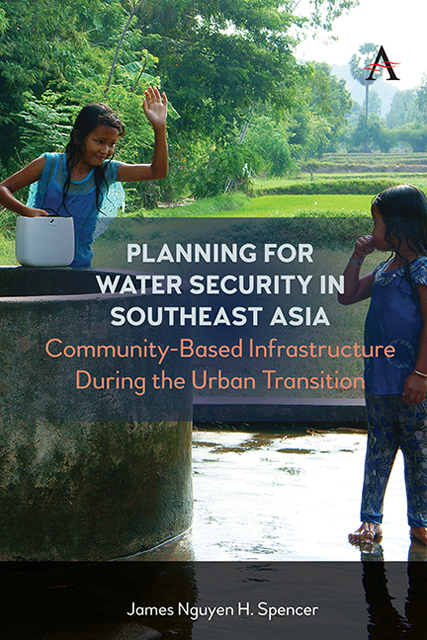 Planning for Water Security in Southeast Asia
Planning for Water Security in Southeast Asia Book contents
- Frontmatter
- Content
- Preface
- Introduction
- 1 Water and Human Security
- 2 Global Urbanization: The Confluence of Peri-Urbanization and Urban Transition
- 3 Community-Based Public Finance of Deep Well Water Systems in Peri-Urban Java
- 4 The Peri-Urbanization of Can Tho and the rise of Entrepreneurial Water Suppliers in the Mekong Delta
- 5 Ha Noi: Bulk Water Retailing in Peri-Urban Areas
- 6 Peri-Urbanization, Co-Production and Institutional Culture: The Case of the Phnom Penh Water Supply Authority
- 7 Beyond Resilience: Are we thinking about Entitlements, Participation and Governance in the Right Way?
- References
- Index
1 - Water and Human Security
Published online by Cambridge University Press: 10 January 2023
- Frontmatter
- Content
- Preface
- Introduction
- 1 Water and Human Security
- 2 Global Urbanization: The Confluence of Peri-Urbanization and Urban Transition
- 3 Community-Based Public Finance of Deep Well Water Systems in Peri-Urban Java
- 4 The Peri-Urbanization of Can Tho and the rise of Entrepreneurial Water Suppliers in the Mekong Delta
- 5 Ha Noi: Bulk Water Retailing in Peri-Urban Areas
- 6 Peri-Urbanization, Co-Production and Institutional Culture: The Case of the Phnom Penh Water Supply Authority
- 7 Beyond Resilience: Are we thinking about Entitlements, Participation and Governance in the Right Way?
- References
- Index
Summary
Before describing community strategies for securing safe water, it is important to appreciate the significance of water security as a global challenge for the twenty-first century. Both US News and World Report and the Asian Development Bank (ADB) have focused on water as one of the major environmental concerns of the twenty-first century, while others have compared the future demand for fresh water with the energy crisis in its unequal distribution, inefficient pricing and its ability to drastically affect human societies if left unresolved. Whether the issue is security or equity, the increasing demand and declining supply of fresh water is an important topic of contemporary public debate especially in SEA and other areas of the rapidly urbanizing Global South.
The Dire Statistics
Water is, of course, the primary resource supporting life and is fundamental to human existence regardless of nation, demographics or socio-economic status. Increased access to water has far reaching effects and providing the right quality and quantity of water for food and energy promotes economic growth and stability, poverty reduction and food and energy production. Access to water is crucial to the preservation of our ecosystems on which our lives depend, as well as dependent on these very ecosystems to sustain water (UNESCO, 2006). Yet for something so important, there is relatively little of it on the earth; 99 percent of the world's water is either saltwater or locked up in glaciers in its frozen form (PWC, 2012). And while the remaining 1 percent must serve all our human needs, these same freshwater resources simultaneously maintain our natural ecosystem (PWC, 2013).
The UN Food and Agriculture Organization estimates that 2.8 billion people already live in water-stressed areas and that this could rise to two-thirds of the world's population by 2025. Global demand for water has increased sixfold in the past century, more than double the rate of global population growth and the World Bank estimates demand may grow more than 50 percent by 2030 (PWC, 2012).
According to the Center for Strategic and International Studies’ 2005 report, Addressing Our Global Water Future: “Widespread over-consumption of freshwater resources is causing a collapse in global freshwater systems that will be a primary driver in future water scarcity.”
- Type
- Chapter
- Information
- Planning for Water Security in Southeast AsiaCommunity-Based Infrastructure During the Urban Transition, pp. 25 - 46Publisher: Anthem PressPrint publication year: 2022


